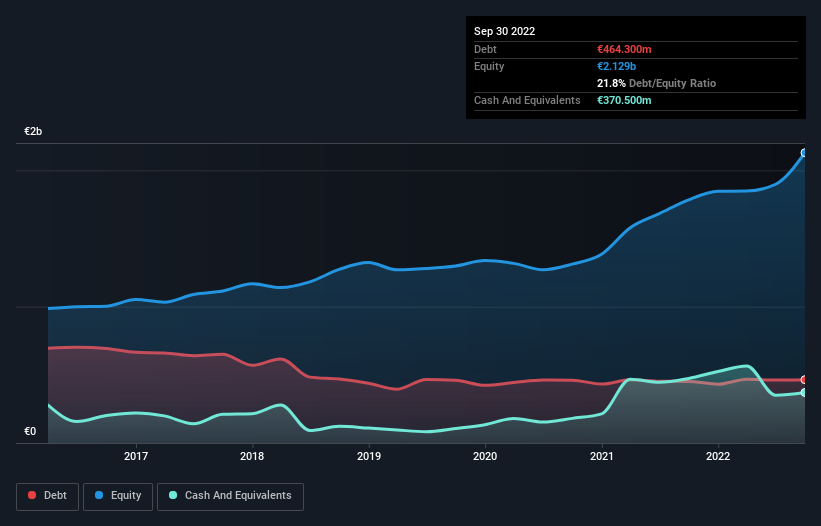Here's Why Metsä Board Oyj (HEL:METSB) Can Manage Its Debt Responsibly
Warren Buffett famously said, 'Volatility is far from synonymous with risk.' So it might be obvious that you need to consider debt, when you think about how risky any given stock is, because too much debt can sink a company. We note that Metsä Board Oyj (HEL:METSB) does have debt on its balance sheet. But is this debt a concern to shareholders?
When Is Debt A Problem?
Debt and other liabilities become risky for a business when it cannot easily fulfill those obligations, either with free cash flow or by raising capital at an attractive price. If things get really bad, the lenders can take control of the business. However, a more usual (but still expensive) situation is where a company must dilute shareholders at a cheap share price simply to get debt under control. Of course, plenty of companies use debt to fund growth, without any negative consequences. When we examine debt levels, we first consider both cash and debt levels, together.
View our latest analysis for Metsä Board Oyj
What Is Metsä Board Oyj's Debt?
As you can see below, Metsä Board Oyj had €464.3m of debt, at September 2022, which is about the same as the year before. You can click the chart for greater detail. However, because it has a cash reserve of €370.5m, its net debt is less, at about €93.8m.

How Healthy Is Metsä Board Oyj's Balance Sheet?
The latest balance sheet data shows that Metsä Board Oyj had liabilities of €632.1m due within a year, and liabilities of €568.9m falling due after that. Offsetting this, it had €370.5m in cash and €497.6m in receivables that were due within 12 months. So its liabilities outweigh the sum of its cash and (near-term) receivables by €332.9m.
Since publicly traded Metsä Board Oyj shares are worth a total of €3.04b, it seems unlikely that this level of liabilities would be a major threat. Having said that, it's clear that we should continue to monitor its balance sheet, lest it change for the worse.
We use two main ratios to inform us about debt levels relative to earnings. The first is net debt divided by earnings before interest, tax, depreciation, and amortization (EBITDA), while the second is how many times its earnings before interest and tax (EBIT) covers its interest expense (or its interest cover, for short). Thus we consider debt relative to earnings both with and without depreciation and amortization expenses.
Metsä Board Oyj's net debt is only 0.24 times its EBITDA. And its EBIT easily covers its interest expense, being 530 times the size. So you could argue it is no more threatened by its debt than an elephant is by a mouse. Another good sign is that Metsä Board Oyj has been able to increase its EBIT by 22% in twelve months, making it easier to pay down debt. The balance sheet is clearly the area to focus on when you are analysing debt. But ultimately the future profitability of the business will decide if Metsä Board Oyj can strengthen its balance sheet over time. So if you're focused on the future you can check out this free report showing analyst profit forecasts.
Finally, a business needs free cash flow to pay off debt; accounting profits just don't cut it. So the logical step is to look at the proportion of that EBIT that is matched by actual free cash flow. In the last three years, Metsä Board Oyj's free cash flow amounted to 38% of its EBIT, less than we'd expect. That weak cash conversion makes it more difficult to handle indebtedness.
Our View
Happily, Metsä Board Oyj's impressive interest cover implies it has the upper hand on its debt. But, on a more sombre note, we are a little concerned by its conversion of EBIT to free cash flow. Zooming out, Metsä Board Oyj seems to use debt quite reasonably; and that gets the nod from us. While debt does bring risk, when used wisely it can also bring a higher return on equity. The balance sheet is clearly the area to focus on when you are analysing debt. But ultimately, every company can contain risks that exist outside of the balance sheet. For example Metsä Board Oyj has 2 warning signs (and 1 which is a bit unpleasant) we think you should know about.
At the end of the day, it's often better to focus on companies that are free from net debt. You can access our special list of such companies (all with a track record of profit growth). It's free.
New: Manage All Your Stock Portfolios in One Place
We've created the ultimate portfolio companion for stock investors, and it's free.
• Connect an unlimited number of Portfolios and see your total in one currency
• Be alerted to new Warning Signs or Risks via email or mobile
• Track the Fair Value of your stocks
Have feedback on this article? Concerned about the content? Get in touch with us directly. Alternatively, email editorial-team (at) simplywallst.com.
This article by Simply Wall St is general in nature. We provide commentary based on historical data and analyst forecasts only using an unbiased methodology and our articles are not intended to be financial advice. It does not constitute a recommendation to buy or sell any stock, and does not take account of your objectives, or your financial situation. We aim to bring you long-term focused analysis driven by fundamental data. Note that our analysis may not factor in the latest price-sensitive company announcements or qualitative material. Simply Wall St has no position in any stocks mentioned.
About HLSE:METSB
Metsä Board Oyj
Engages in the folding boxboard, fresh fibre linerboard, and market pulp businesses in Finland and internationally.
Undervalued with reasonable growth potential.
Similar Companies
Market Insights
Community Narratives





